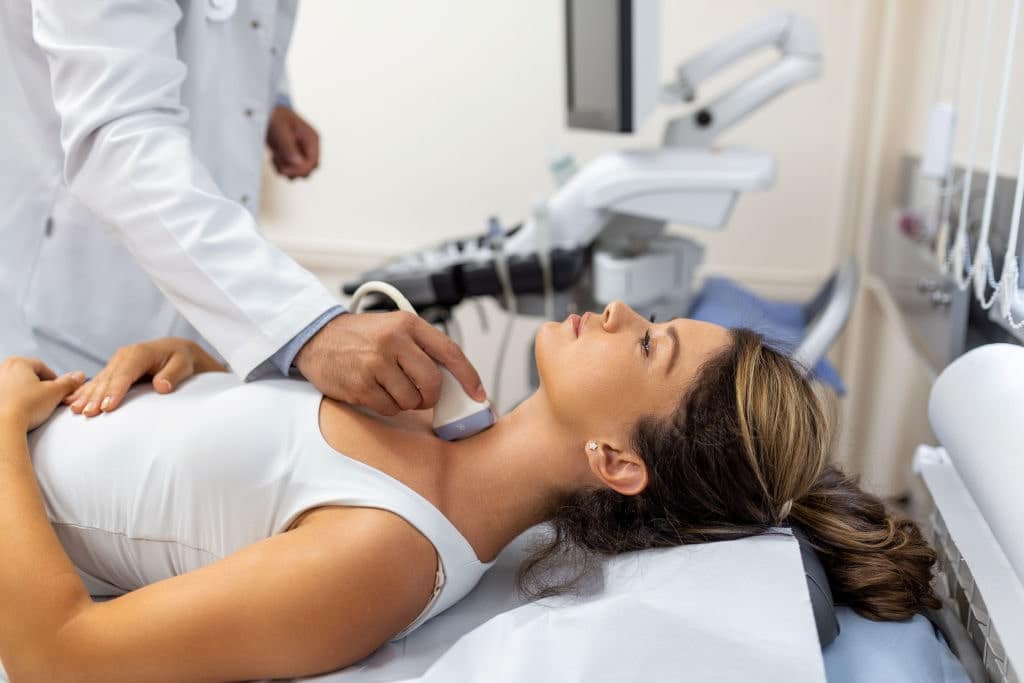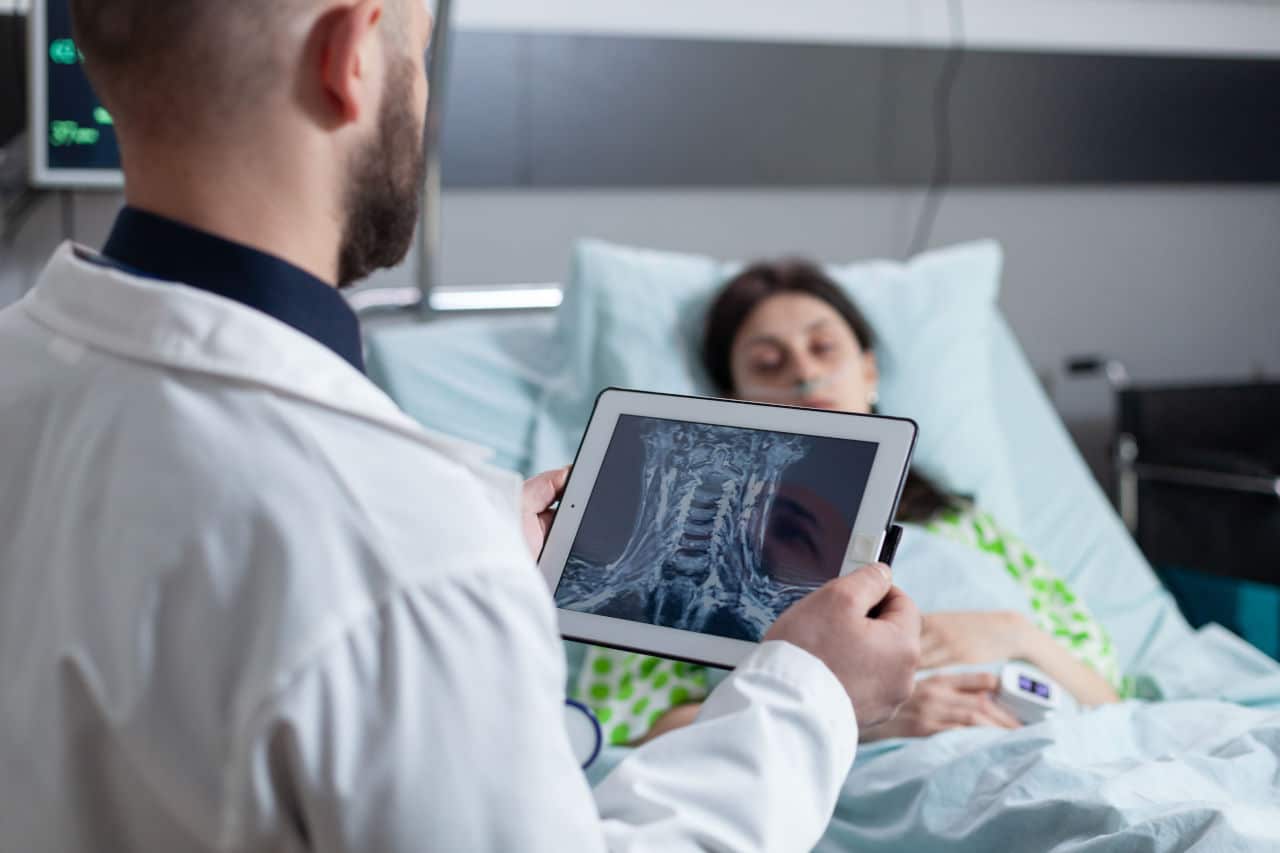Laryngoscopy is a procedure that healthcare professionals do to inspect the larynx (voice box). It is a useful procedure for finding the causes of voice and breathing issues, pain in the throat or ear, difficulty swallowing, throat narrowing, and airway obstructions. This procedure is helpful in various medical situations, including the emergency room, intensive care unit, and operating room.
The larynx or voice box is an organ responsible for voice production. It contains two bands of tissue known as vocal cords or vocal folds. It is located inside the neck, directly at the top of the windpipe or trachea.
When we breathe, the vocal cords open up, allowing air to enter and exit the lungs. However, the vocal cords converge when we talk, resulting in a restricted passageway for the lungs’ breath. The vocal cords tremble as a result of this. These vibrations produce a person’s voice as they travel up the throat and out of the mouth.
The larynx is also helpful in preventing foreign objects from entering the lower airway. Hence, contributing significantly to lung protection.
This procedure uses a laryngoscope. A laryngoscope is a little tube with a light, lens, and camera. It enables medical professionals to see the larynx clearly. Medical professionals can perform laryngoscopies in an operating room or clinic office.
When Is A Laryngoscopy Needed?
Laryngoscopy can be recommended to diagnose several problems.
When a person has voice or throat pain that won’t go away, laryngoscopy can be used. It can help identify the origins of symptoms in the voice box or throat.
Additionally, laryngoscopy may be utilized to look closely at an abnormality detected during an imaging examination (such as a CT scan).
Laryngoscopy can also be needed to treat throat or vocal cord problems. For example, the procedure can remove tiny growths on the vocal cords (such as polyps or tumors).
Another circumstance in which laryngoscopy can be used is when the doctor needs to look at something that might indicate a more serious health issue, like cancer.

What Are Some Possible Complications That Can Occur During A Laryngoscopy?
Laryngoscopy is a relatively safe procedure. This is because it is a less invasive procedure. However, several complications could arise after this surgical procedure.
It is essential to note that these complications are all known risks associated with laryngoscopy. However, in some exceptional situations, they can be caused by the negligence of the laryngoscopist. Let’s consider the three most common complications that arise after laryngoscopy.
Bleeding
Much like most surgeries, bleeding is a known risk of laryngoscopy. It occurs when small, vulnerable blood vessels in the mucous membrane are injured during the surgical procedure.
Bleeding during laryngoscopy is an emergency. It requires the laryngoscopist to promptly find the exact location of the bleeding and maintain it. This is very important because the patient can spit out the blood in their trachea while conscious. However, if the patient is unconscious, the tracheal blood may flow into the distal portion, which could be fatal due to pulmonary aspiration.
Infection
Another complication that can arise after a laryngoscopy is an infection. The use of a laryngoscope mainly causes this infection. Therefore, the laryngoscope is an essential, indispensable tool used during a laryngoscopy.
The laryngoscope often interacts with the mucous membrane, saliva, and blood. Hence, such a device must be kept sterilized at all times.
There are, however, situations where the laryngoscopist does not thoroughly sterilize and clean the laryngoscope. The device then habits bacteria that would infect the patient.
In a survey conducted by the Journal of Anaesthesiology, 100 anesthesiologists were selected for the study. The study was to determine the rate at which anesthesiologists clean and disinfect the laryngoscope before use. The study revealed that 54% of the anesthesiologists did not disinfect or sterilize their blades before use.
Injury to the larynx or surrounding tissue
Injury to the larynx can occur when the laryngeal nerves are damaged during laryngoscopy. When this happens, a laryngeal injury can lead to hoarseness, difficulty breathing and swallowing, or even loss of voice.

Using Medical Animation to Prove Liability In Laryngoscopy Malpractice Trial
Laryngoscopy is a relatively simple procedure that comes with little or no complications. However, the negligence of an anesthesiologist can make a simple procedure such as this a big deal.
Imagine a patient who comes to the hospital to find out if something is wrong with his throat or larynx, only to leave with a punctured larynx or a bigger problem.
When medical malpractice occurs, proving liability is not always an easy job. Especially in malpractice claims that involve laryngoscopy. This is because laryngoscopy is a straightforward procedure that has a record of outstanding success.
The negligent doctors will always seek ways to absolve themselves of the guilt. Nevertheless, with medical animation, establishing liability for the complications that arise can be made a lot easier.
Hence, one of the essential elements of a laryngoscopy medical malpractice claim that must be proved is that the doctor deviated from the standard duty of care.
In establishing that element, an expert witness must be employed.
Let’s consider the case of Piquette v. Midtown Anaesthesia Associates. In this instance, the plaintiff underwent a laryngoscopy to view his throat and perform a biopsy. After the procedure, the plaintiff started experiencing great difficulty speaking.
The court, however, ruled for the defendants because the plaintiff’s expert witness could not show a causal link between the harm suffered and the doctor’s actions.
As seen above, the argument of an expert witness is a major determinant of the outcome of a laryngoscopy claim.
In cases such as this, medical animation can be used to establish the expert witness’s credibility. In addition, it can help the jury visualize what occurred.
Conclusion
Laryngoscopy medical malpractice can have a devastating effect on a victim. Hence, using medical animation, an essential tool employed in courtrooms to enhance key arguments to a jury or judge, is vital.
Partnering with a medical animation company, like Fox-AE, with a track record of producing precise and effective demonstrative exhibits is essential. At Fox-AE, we work closely with attorneys and expert witnesses to ensure we create admissible medical illustrations.






